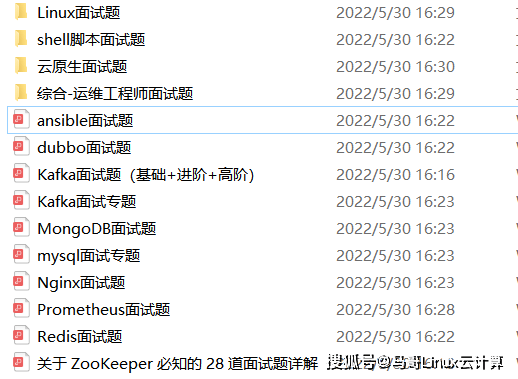为了做好运维面试路上的助攻手,特整理了上百道 【运维技术栈面试题集锦】 ,让你面试不慌心不跳,高薪offer怀里抱!
这次整理的面试题,小到shell、MySQL,大到K8s等云原生技术栈,不仅适合运维新人入行面试需要,还适用于想提升进阶跳槽加薪的运维朋友。

本份面试集锦涵盖了
- 174 道运维工程师面试题
- 128道k8s面试题
- 108道shell脚本面试题
- 200道Linux面试题
- 51道docker面试题
- 35道Jenkis面试题
- 78道MongoDB面试题
- 17道ansible面试题
- 60道dubbo面试题
- 53道kafka面试
- 18道mysql面试题
- 40道nginx面试题
- 77道redis面试题
- 28道zookeeper
总计 1000+ 道面试题, 内容 又全含金量又高
- 174道运维工程师面试题
1、什么是运维?
2、在工作中,运维人员经常需要跟运营人员打交道,请问运营人员是做什么工作的?
3、现在给你三百台服务器,你怎么对他们进行管理?
4、简述raid0 raid1raid5二种工作模式的工作原理及特点
5、LVS、Nginx、HAproxy有什么区别?工作中你怎么选择?
6、Squid、Varinsh和Nginx有什么区别,工作中你怎么选择?
7、Tomcat和Resin有什么区别,工作中你怎么选择?
8、什么是中间件?什么是jdk?
9、讲述一下Tomcat8005、8009、8080三个端口的含义?
10、什么叫CDN?
11、什么叫网站灰度发布?
12、简述DNS进行域名解析的过程?
13、RabbitMQ是什么东西?
14、讲一下Keepalived的工作原理?
15、讲述一下LVS三种模式的工作过程?
16、mysql的innodb如何定位锁问题,mysql如何减少主从复制延迟?
17、如何重置mysql root密码?
网上学习资料一大堆,但如果学到的知识不成体系,遇到问题时只是浅尝辄止,不再深入研究,那么很难做到真正的技术提升。
一个人可以走的很快,但一群人才能走的更远!不论你是正从事IT行业的老鸟或是对IT行业感兴趣的新人,都欢迎加入我们的的圈子(技术交流、学习资源、职场吐槽、大厂内推、面试辅导),让我们一起学习成长!
/etc/shells
peida-VirtualBox ~ #
**实例3:搜索etc目录下,所有以m开头的文件**
**命令:**
locate /etc/m
**输出:**
peida-VirtualBox ~ # locate /etc/m
/etc/magic
/etc/magic.mime
/etc/mailcap
/etc/mailcap.order
/etc/manpath.config
/etc/mate-settings-daemon
### find 命令语法
Linux下find命令在目录结构中搜索文件,并执行指定的操作。Linux下find命令提供了相当多的查找条件,功能很强大。由于find具有强大的功能,所以它的选项也很多,其中大部分选项都值得我们花时间来了解一下。即使系统中含有网络文件系统( NFS),find命令在该文件系统中同样有效,只你具有相应的权限。 在运行一个非常消耗资源的find命令时,很多人都倾向于把它放在后台执行,因为遍历一个大的文件系统可能会花费很长的时间(这里是指30G字节以上的文件系统)。
1.命令格式:
find pathname -options [-print -exec -ok …]
2.命令功能:
用于在文件树种查找文件,并作出相应的处理
3.命令参数:
pathname: find命令所查找的目录路径。例如用.来表示当前目录,用/来表示系统根目录。
-print: find命令将匹配的文件输出到标准输出。
-exec: find命令对匹配的文件执行该参数所给出的shell命令。相应命令的形式为’command’ { } ;,注意{ }和\;之间的空格。
-ok: 和-exec的作用相同,只不过以一种更为安全的模式来执行该参数所给出的shell命令,在执行每一个命令之前,都会给出提示,让用户来确定是否执行。
4.命令选项:
-name 按照文件名查找文件。
-perm 按照文件权限来查找文件。
-prune 使用这一选项可以使find命令不在当前指定的目录中查找,如果同时使用-depth选项,那么-prune将被find命令忽略。
-user 按照文件属主来查找文件。
-group 按照文件所属的组来查找文件。
-mtime -n +n 按照文件的更改时间来查找文件, - n表示文件更改时间距现在n天以内,+ n表示文件更改时间距现在n天以前。find命令还有-atime和-ctime 选项,但它们都和-m time选项。
-nogroup 查找无有效所属组的文件,即该文件所属的组在/etc/groups中不存在。
-nouser 查找无有效属主的文件,即该文件的属主在/etc/passwd中不存在。
-newer file1 ! file2 查找更改时间比文件file1新但比文件file2旧的文件。
-type 查找某一类型的文件,诸如:
b - 块设备文件。
d - 目录。
c - 字符设备文件。
p - 管道文件。
l - 符号链接文件。
f - 普通文件。
-size n:[c] 查找文件长度为n块的文件,带有c时表示文件长度以字节计。-depth:在查找文件时,首先查找当前目录中的文件,然后再在其子目录中查找。
-fstype:查找位于某一类型文件系统中的文件,这些文件系统类型通常可以在配置文件/etc/fstab中找到,该配置文件中包含了本系统中有关文件系统的信息。
-mount:在查找文件时不跨越文件系统mount点。
-follow:如果find命令遇到符号链接文件,就跟踪至链接所指向的文件。
-cpio:对匹配的文件使用cpio命令,将这些文件备份到磁带设备中。
另外,下面三个的区别:
-amin n 查找系统中最后N分钟访问的文件
-atime n 查找系统中最后n\*24小时访问的文件
-cmin n 查找系统中最后N分钟被改变文件状态的文件
-ctime n 查找系统中最后n\*24小时被改变文件状态的文件
-mmin n 查找系统中最后N分钟被改变文件数据的文件
-mtime n 查找系统中最后n\*24小时被改变文件数据的文件
### find命令使用示例
\*\*实例1:\*\***查找指定时间内修改过的文件**
**命令:**
find -atime -2
**输出:**
[root@peidachang ~]# find -atime -2
.
./logs/monitor
./.bashrc
./.bash_profile
./.bash_history
**说明:**
超找48小时内修改过的文件
\*\*实例2:\*\***根据关键字查找**
**命令:**
find . -name “*.log”
**输出:**
[root@localhost test]# find . -name “*.log”
./log_link.log
./log2014.log
./test4/log3-2.log
./test4/log3-3.log
./test4/log3-1.log
./log2013.log
./log2012.log
./log.log
./test5/log5-2.log
./test5/log5-3.log
./test5/log.log
./test5/log5-1.log
./test5/test3/log3-2.log
./test5/test3/log3-3.log
./test5/test3/log3-1.log
./test3/log3-2.log
./test3/log3-3.log
./test3/log3-1.log
**说明:**
在当前目录查找 以.log结尾的文件。 "**.** "代表当前目录
\*\*实例3:\*\***按照目录或文件的权限来查找文件**
**命令:**
find /opt/soft/test/ -perm 777
**输出:**
[root@localhost test]# find /opt/soft/test/ -perm 777
/opt/soft/test/log_link.log
/opt/soft/test/test4
/opt/soft/test/test5/test3
/opt/soft/test/test3
**说明:**
查找/opt/soft/test/目录下 权限为 777的文件
\*\*实例4:\*\***按类型查找**
**命令:**
find . -type f -name “*.log”
**输出:**
[root@localhost test]# find . -type f -name “*.log”
./log2014.log
./test4/log3-2.log
./test4/log3-3.log
./test4/log3-1.log
./log2013.log
./log2012.log
./log.log
./test5/log5-2.log
./test5/log5-3.log
./test5/log.log
./test5/log5-1.log
./test5/test3/log3-2.log
./test5/test3/log3-3.log
./test5/test3/log3-1.log
./test3/log3-2.log
./test3/log3-3.log
./test3/log3-1.log
[root@localhost test]#
**说明:**
查找当目录,以.log结尾的普通文件
**实例5:查找当前所有目录并排序**
**命令:**
find . -type d | sort
**输出:**
[root@localhost test]# find . -type d | sort
.
./scf
./scf/bin
./scf/doc
./scf/lib
./scf/service
./scf/service/deploy
./scf/service/deploy/info
./scf/service/deploy/product
./test3
./test4
./test5
./test5/test3
[root@localhost test]#
**实例6:按大小查找文件**
**命令:**
find . -size +1000c -print
**输出:**
[root@localhost test]# find . -size +1000c -print
.
./test4
./scf
./scf/lib
./scf/service
./scf/service/deploy
./scf/service/deploy/product
./scf/service/deploy/info
./scf/doc
./scf/bin
./log2012.log
./test5
./test5/test3
./test3
[root@localhost test]#
**说明:**
查找当前目录大于1K的文件
### find命令之exec使用示例
find是我们很常用的一个Linux命令,但是我们一般查找出来的并不仅仅是看看而已,还会有进一步的操作,这个时候exec的作用就显现出来了。
**e**xec解释:
-exec 参数后面跟的是command命令,它的终止是以;为结束标志的,所以这句命令后面的分号是不可缺少的,考虑到各个系统中分号会有不同的意义,所以前面加反斜杠。
{} 花括号代表前面find查找出来的文件名。
使用find时,只要把想要的操作写在一个文件里,就可以用exec来配合find查找,很方便的。在有些操作系统中只允许-exec选项执行诸如l s或ls -l这样的命令。大多数用户使用这一选项是为了查找旧文件并删除它们。建议在真正执行rm命令删除文件之前,最好先用ls命令看一下,确认它们是所要删除的文件。 exec选项后面跟随着所要执行的命令或脚本,然后是一对儿{ },一个空格和一个\,最后是一个分号。为了使用exec选项,必须要同时使用print选项。如果验证一下find命令,会发现该命令只输出从当前路径起的相对路径及文件名。
**实例****1****:ls -l命令放在find命令的-exec选项中**
**命令:**
find . -type f -exec ls -l {} ;
**输出:**
[root@localhost test]# find . -type f -exec ls -l {} ;
-rw-r–r-- 1 root root 127 10-28 16:51 ./log2014.log
-rw-r–r-- 1 root root 0 10-28 14:47 ./test4/log3-2.log
-rw-r–r-- 1 root root 0 10-28 14:47 ./test4/log3-3.log
-rw-r–r-- 1 root root 0 10-28 14:47 ./test4/log3-1.log
-rw-r–r-- 1 root root 33 10-28 16:54 ./log2013.log
-rw-r–r-- 1 root root 302108 11-03 06:19 ./log2012.log
-rw-r–r-- 1 root root 25 10-28 17:02 ./log.log
-rw-r–r-- 1 root root 37 10-28 17:07 ./log.txt
-rw-r–r-- 1 root root 0 10-28 14:47 ./test3/log3-2.log
-rw-r–r-- 1 root root 0 10-28 14:47 ./test3/log3-3.log
-rw-r–r-- 1 root root 0 10-28 14:47 ./test3/log3-1.log
[root@localhost test]#
**说明:**
上面的例子中,find命令匹配到了当前目录下的所有普通文件,并在-exec选项中使用ls -l命令将它们列出。
**实例****2:****在目录中查找更改时间在****n****日以前的文件并删除它们**
**命令:**
find . -type f -mtime +14 -exec rm {} ;
**输出:**
[root@localhost test]# ll
总计 328
-rw-r–r-- 1 root root 302108 11-03 06:19 log2012.log
-rw-r–r-- 1 root root 33 10-28 16:54 log2013.log
-rw-r–r-- 1 root root 127 10-28 16:51 log2014.log
lrwxrwxrwx 1 root root 7 10-28 15:18 log_link.log -> log.log
-rw-r–r-- 1 root root 25 10-28 17:02 log.log
-rw-r–r-- 1 root root 37 10-28 17:07 log.txt
drwxr-xr-x 6 root root 4096 10-27 01:58 scf
drwxrwxrwx 2 root root 4096 10-28 14:47 test3
drwxrwxrwx 2 root root 4096 10-28 14:47 test4
[root@localhost test]# find . -type f -mtime +14 -exec rm {} ;
[root@localhost test]# ll
总计 312
-rw-r–r-- 1 root root 302108 11-03 06:19 log2012.log
lrwxrwxrwx 1 root root 7 10-28 15:18 log_link.log -> log.log
drwxr-xr-x 6 root root 4096 10-27 01:58 scf
drwxrwxrwx 2 root root 4096 11-12 19:32 test3
drwxrwxrwx 2 root root 4096 11-12 19:32 test4
[root@localhost test]#
**说明**:
在shell中用任何方式删除文件之前,应当先查看相应的文件,一定要小心!当使用诸如mv或rm命令时,可以使用-exec选项的安全模式。它将在对每个匹配到的文件进行操作之前提示你。
**实例****3:****在目录中查找更改时间在****n****日以前的文件并删除它们**\*\*,\*\***在删除之前先给出提示**
**命令:**
find . -name “*.log” -mtime +5 -ok rm {} ;
**输出:**
[root@localhost test]# ll
总计 312
-rw-r–r-- 1 root root 302108 11-03 06:19 log2012.log
lrwxrwxrwx 1 root root 7 10-28 15:18 log_link.log -> log.log
drwxr-xr-x 6 root root 4096 10-27 01:58 scf
drwxrwxrwx 2 root root 4096 11-12 19:32 test3
drwxrwxrwx 2 root root 4096 11-12 19:32 test4
[root@localhost test]# find . -name “*.log” -mtime +5 -ok rm {} ;
< rm … ./log_link.log > ? y
< rm … ./log2012.log > ? n
[root@localhost test]# ll
总计 312
-rw-r–r-- 1 root root 302108 11-03 06:19 log2012.log
drwxr-xr-x 6 root root 4096 10-27 01:58 scf
drwxrwxrwx 2 root root 4096 11-12 19:32 test3
drwxrwxrwx 2 root root 4096 11-12 19:32 test4
[root@localhost test]#
**说明**:
在上面的例子中, find命令在当前目录中查找所有文件名以.log结尾、更改时间在5日以上的文件,并删除它们,只不过在删除之前先给出提示。 按y键删除文件,按n键不删除。
**实例**4:-exec中使用grep命令
**命令:**
find /etc -name “passwd*” -exec grep “root” {} ;
**输出:**
[root@localhost test]# find /etc -name “passwd*” -exec grep “root” {} ;
root❌0:0:root:/root:/bin/bash
root❌0:0:root:/root:/bin/bash
[root@localhost test]#
**说明:**
任何形式的命令都可以在-exec选项中使用。 在上面的例子中我们使用grep命令。find命令首先匹配所有文件名为“ passwd\*”的文件,例如passwd、passwd.old、passwd.bak,然后执行grep命令看看在这些文件中是否存在一个root用户。
\*\*实例\*\*\*\*5:\*\***查找文件移动到指定目录**
**命令:**
find . -name “*.log” -exec mv {} … ;
**输出:**
[root@localhost test]# ll
总计 12drwxr-xr-x 6 root root 4096 10-27 01:58 scf
drwxrwxr-x 2 root root 4096 11-12 22:49 test3
drwxrwxr-x 2 root root 4096 11-12 19:32 test4
[root@localhost test]# cd test3/
[root@localhost test3]# ll
总计 304
-rw-r–r-- 1 root root 302108 11-03 06:19 log2012.log
-rw-r–r-- 1 root root 61 11-12 22:44 log2013.log
-rw-r–r-- 1 root root 0 11-12 22:25 log2014.log
[root@localhost test3]# find . -name “*.log” -exec mv {} … ;
[root@localhost test3]# ll
总计 0[root@localhost test3]# cd …
[root@localhost test]# ll
总计 316
-rw-r–r-- 1 root root 302108 11-03 06:19 log2012.log
-rw-r–r-- 1 root root 61 11-12 22:44 log2013.log
-rw-r–r-- 1 root root 0 11-12 22:25 log2014.log
drwxr-xr-x 6 root root 4096 10-27 01:58 scf
drwxrwxr-x 2 root root 4096 11-12 22:50 test3
drwxrwxr-x 2 root root 4096 11-12 19:32 test4
[root@localhost test]#
**实例**6:用exec选项执行cp命令
**命令:**
find . -name “*.log” -exec cp {} test3 ;
**输出:**
[root@localhost test3]# ll
总计 0[root@localhost test3]# cd …
[root@localhost test]# ll
总计 316
-rw-r–r-- 1 root root 302108 11-03 06:19 log2012.log
-rw-r–r-- 1 root root 61 11-12 22:44 log2013.log
-rw-r–r-- 1 root root 0 11-12 22:25 log2014.log
drwxr-xr-x 6 root root 4096 10-27 01:58 scf
drwxrwxr-x 2 root root 4096 11-12 22:50 test3
drwxrwxr-x 2 root root 4096 11-12 19:32 test4
[root@localhost test]# find . -name “*.log” -exec cp {} test3 ;
cp: “./test3/log2014.log” 及 “test3/log2014.log” 为同一文件
cp: “./test3/log2013.log” 及 “test3/log2013.log” 为同一文件
cp: “./test3/log2012.log” 及 “test3/log2012.log” 为同一文件
[root@localhost test]# cd test3
[root@localhost test3]# ll
总计 304
-rw-r–r-- 1 root root 302108 11-12 22:54 log2012.log
-rw-r–r-- 1 root root 61 11-12 22:54 log2013.log
-rw-r–r-- 1 root root 0 11-12 22:54 log2014.log
[root@localhost test3]#
### find 命令的参数详解
find一些常用参数的一些常用实例和一些具体用法和注意事项。
\*\*1.\*\*使用name选项:
文件名选项是find命令最常用的选项,要么单独使用该选项,要么和其他选项一起使用。 可以使用某种文件名模式来匹配文件,记住要用引号将文件名模式引起来。 不管当前路径是什么,如果想要在自己的根目录
H
O
M
E
中
查
找
文
件
名
符
合
∗
.
l
o
g
的
文
件
,
使
用
作
为
′
p
a
t
h
n
a
m
e
′
参
数
,
波
浪
号
代
表
了
你
的
HOME中查找文件名符合\*.log的文件,使用~作为 'pathname'参数,波浪号~代表了你的
HOME中查找文件名符合∗.log的文件,使用 作为′pathname′参数,波浪号 代表了你的HOME目录。
find ~ -name “*.log” -print
想要在当前目录及子目录中查找所有的‘ \*.log‘文件,可以用:
find . -name “*.log” -print
想要的当前目录及子目录中查找文件名以一个大写字母开头的文件,可以用:
find . -name “[A-Z]*” -print
想要在/etc目录中查找文件名以host开头的文件,可以用:
find /etc -name “host*” -print
想要查找$HOME目录中的文件,可以用:
find ~ -name “*” -print 或find . -print
要想让系统高负荷运行,就从根目录开始查找所有的文件。
find / -name “*” -print
如果想在当前目录查找文件名以一个个小写字母开头,最后是4到9加上.log结束的文件:
命令:
find . -name “[a-z]*[4-9].log” -print
输出:
[root@localhost test]# ll
总计 316
-rw-r–r-- 1 root root 302108 11-13 06:03 log2012.log
-rw-r–r-- 1 root root 61 11-13 06:03 log2013.log
-rw-r–r-- 1 root root 0 11-13 06:03 log2014.log
-rw-r–r-- 1 root root 0 11-13 06:06 log2015.log
drwxr-xr-x 6 root root 4096 10-27 01:58 scf
drwxrwxr-x 2 root root 4096 11-13 06:08 test3
drwxrwxr-x 2 root root 4096 11-13 05:50 test4
[root@localhost test]# find . -name “[a-z]*[4-9].log” -print
./log2014.log
./log2015.log
./test4/log2014.log
[root@localhost test]#
\*\*2.\*\*用perm选项:
按照文件权限模式用-perm选项,按文件权限模式来查找文件的话。最好使用八进制的权限表示法。
如在当前目录下查找文件权限位为755的文件,即文件属主可以读、写、执行,其他用户可以读、执行的文件,可以用:
[root@localhost test]# find . -perm 755 -print
.
./scf
./scf/lib
./scf/service
./scf/service/deploy
./scf/service/deploy/product
./scf/service/deploy/info
./scf/doc
./scf/bin
[root@localhost test]#
还有一种表达方法:在八进制数字前面要加一个横杠-,表示都匹配,如-007就相当于777,-005相当于555,
**命令:**
find . -perm -005
**输出:**
[root@localhost test]# ll
总计 316
-rw-r–r-- 1 root root 302108 11-13 06:03 log2012.log
-rw-r–r-- 1 root root 61 11-13 06:03 log2013.log
-rw-r–r-- 1 root root 0 11-13 06:03 log2014.log
-rw-r–r-- 1 root root 0 11-13 06:06 log2015.log
drwxr-xr-x 6 root root 4096 10-27 01:58 scf
drwxrwxr-x 2 root root 4096 11-13 06:08 test3
drwxrwxr-x 2 root root 4096 11-13 05:50 test4
[root@localhost test]# find . -perm -005
.
./test4
./scf
./scf/lib
./scf/service
./scf/service/deploy
./scf/service/deploy/product
./scf/service/deploy/info
./scf/doc
./scf/bin
./test3
[root@localhost test]#
\*\*3.\*\*忽略某个目录:
如果在查找文件时希望忽略某个目录,因为你知道那个目录中没有你所要查找的文件,那么可以使用-prune选项来指出需要忽略的目录。在使用-prune选项时要当心,因为如果你同时使用了-depth选项,那么-prune选项就会被find命令忽略。如果希望在test目录下查找文件,但不希望在test/test3目录下查找,可以用:
**命令:**
find test -path “test/test3” -prune -o -print
**输出:**
[root@localhost soft]# find test -path “test/test3” -prune -o -print
test
test/log2014.log
test/log2015.log
test/test4
test/test4/log2014.log
test/test4/log2013.log
test/test4/log2012.log
test/scf
test/scf/lib
test/scf/service
test/scf/service/deploy
test/scf/service/deploy/product
test/scf/service/deploy/info
test/scf/doc
test/scf/bin
test/log2013.log
test/log2012.log
[root@localhost soft]#
\*\*4.\*\*使用find查找文件的时候怎么避开某个文件目录:
\*\*实例1:\*\*在test 目录下查找不在test4子目录之内的所有文件
**命令:**
find test -path “test/test4” -prune -o -print
**输出:**
[root@localhost soft]# find test
test
test/log2014.log
test/log2015.log
test/test4
test/test4/log2014.log
test/test4/log2013.log
test/test4/log2012.log
test/scf
test/scf/lib
test/scf/service
test/scf/service/deploy
test/scf/service/deploy/product
test/scf/service/deploy/info
test/scf/doc
test/scf/bin
test/log2013.log
test/log2012.log
test/test3
[root@localhost soft]# find test -path “test/test4” -prune -o -print
test
test/log2014.log
test/log2015.log
test/scf
test/scf/lib
test/scf/service
test/scf/service/deploy
test/scf/service/deploy/product
test/scf/service/deploy/info
test/scf/doc
最后的话
最近很多小伙伴找我要Linux学习资料,于是我翻箱倒柜,整理了一些优质资源,涵盖视频、电子书、PPT等共享给大家!
资料预览
给大家整理的视频资料:

给大家整理的电子书资料:

如果本文对你有帮助,欢迎点赞、收藏、转发给朋友,让我有持续创作的动力!
网上学习资料一大堆,但如果学到的知识不成体系,遇到问题时只是浅尝辄止,不再深入研究,那么很难做到真正的技术提升。
一个人可以走的很快,但一群人才能走的更远!不论你是正从事IT行业的老鸟或是对IT行业感兴趣的新人,都欢迎加入我们的的圈子(技术交流、学习资源、职场吐槽、大厂内推、面试辅导),让我们一起学习成长!
est/log2012.log
[root@localhost soft]#
\*\*4.\*\*使用find查找文件的时候怎么避开某个文件目录:
\*\*实例1:\*\*在test 目录下查找不在test4子目录之内的所有文件
**命令:**
find test -path “test/test4” -prune -o -print
**输出:**
[root@localhost soft]# find test
test
test/log2014.log
test/log2015.log
test/test4
test/test4/log2014.log
test/test4/log2013.log
test/test4/log2012.log
test/scf
test/scf/lib
test/scf/service
test/scf/service/deploy
test/scf/service/deploy/product
test/scf/service/deploy/info
test/scf/doc
test/scf/bin
test/log2013.log
test/log2012.log
test/test3
[root@localhost soft]# find test -path “test/test4” -prune -o -print
test
test/log2014.log
test/log2015.log
test/scf
test/scf/lib
test/scf/service
test/scf/service/deploy
test/scf/service/deploy/product
test/scf/service/deploy/info
test/scf/doc
最后的话
最近很多小伙伴找我要Linux学习资料,于是我翻箱倒柜,整理了一些优质资源,涵盖视频、电子书、PPT等共享给大家!
资料预览
给大家整理的视频资料:
[外链图片转存中…(img-1lUAoKzv-1715008180612)]
给大家整理的电子书资料:
[外链图片转存中…(img-BRdhG8rO-1715008180612)]
如果本文对你有帮助,欢迎点赞、收藏、转发给朋友,让我有持续创作的动力!
网上学习资料一大堆,但如果学到的知识不成体系,遇到问题时只是浅尝辄止,不再深入研究,那么很难做到真正的技术提升。
一个人可以走的很快,但一群人才能走的更远!不论你是正从事IT行业的老鸟或是对IT行业感兴趣的新人,都欢迎加入我们的的圈子(技术交流、学习资源、职场吐槽、大厂内推、面试辅导),让我们一起学习成长!






















 2493
2493











 被折叠的 条评论
为什么被折叠?
被折叠的 条评论
为什么被折叠?








